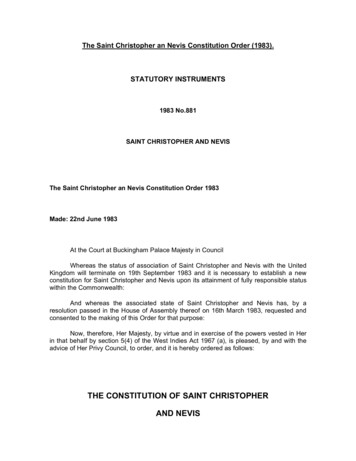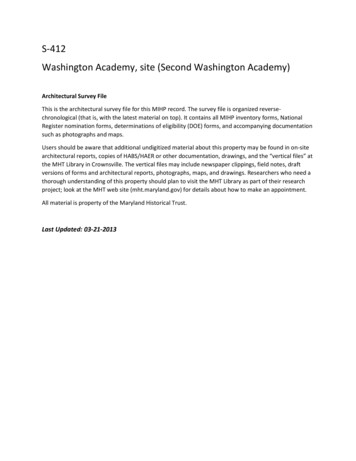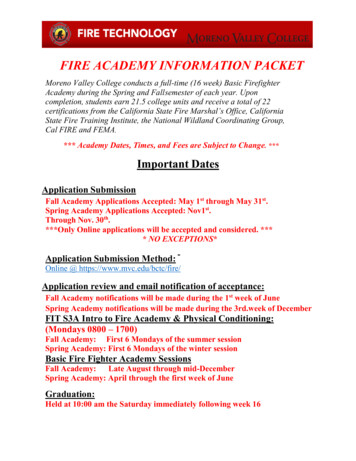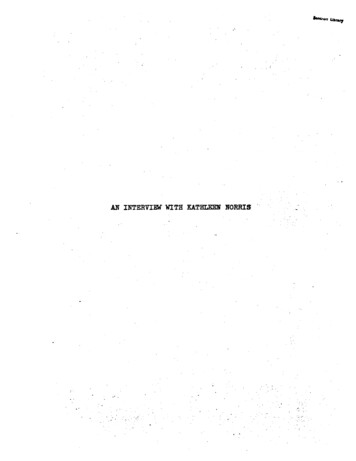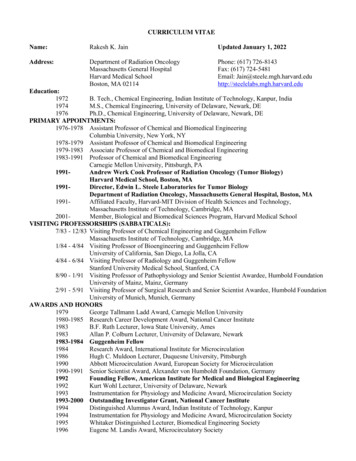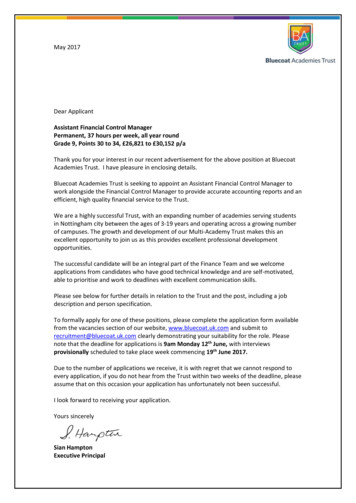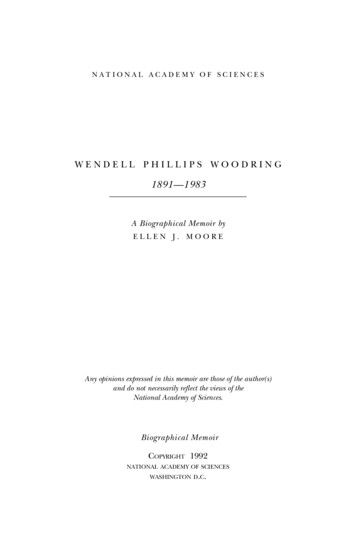
Transcription
national academy of sciencesWendell phillips Woodring1891—1983A Biographical Memoir byellen j. mooreAny opinions expressed in this memoir are those of the author(s)and do not necessarily reflect the views of theNational Academy of Sciences.Biographical MemoirCopyright 1992national academy of scienceswashington d.c.
WENDELL PHILLIPS WOODRINGJune 13, 1891-January 29, 1983BY ELLEN J. MOOREWworked for the U.S. Geological Survey (USGS) almost continuously for overforty-five years. His first job with the USGS was as a fieldassistant (or roustabout, as he called it) during the summer of 1912. This may have been the time he set his partychief adrift in a boat on a fast-moving river with the oarsaboard but without the oarlocks in place. In spite of thisyouthful blunder, he was given a second chance, and hebecame an internationally recognized authority on Tertiary fossils of the Caribbean, Central America, andCalifornia.Wdodfing's recognition of time-equivalent dissimilar lithologic facies in the California Coast Range brought order toa near-chaotic complexity, and it is the basis for all subsequent studies in that area. His painstaking and probingstudies of Cenozoic nlolluscan faunas in the Caribbean andthe adjacent eastern Pacific led to his estimate of almostprecisely at the Pliocene-Pleistocene boundary for the comple-*tion of the Panamanian sea barrier and land bridge. Thisestimate also established the time of initiation of the greatPleistocene mammal migration* between North and SouthAmerica.ENDELL PHILLIPS WOODRING499
500BIOGRAPHICAL MEMOIRSWendell Woodring was born June 13, 1891, in Reading,Pennsylvania, and was named for the abolitionist WendellPhillips, whom his father admired. His great-great-greatgrandfather Samuel Wotring changed his name to Woodringwhen he landed in Philadelphia in 1749. The family nameoriginally was Vautrin in Lorraine, France, but was teutonizedto Wotring after the Massacre of St. Bartholomew Day, whenthe family fled to Alsace, then part of Germany. His father, James Daniel Woodring, a minister in the Evangelical(now United Methodist) Church, was installed as presidentof Albright College, the educational institute of the church.Woodring's mother, Margaret Kurtz Hurst, was of GermanSwiss ancestry. His father died in 1908, leaving his motherthe task of supporting their six children on meager resources. Woodring graduated from Albright College in 1910at the age of nineteen and taught high school science classesat St. James, Minnesota.In 1912 he went to the Department of Geology at JohnsHopkins University as a graduate student. Although Woodringfelt he was "woefully unprepared," the chairman of thedepartment, William Bullock Clark, merely recommendedthat Woodring take undergraduate courses in geology andmineralogy during his first year. This he did under ProfessorCharles Schwartz, whom he found inspiring. He was also influenced by Professor Harry Fielding Reid, who had justpublished his elastic-rebound theory of earthquakes, andby Edward Berry, professor of paleontology. Woodring wasawarded his Ph.D. in 1916.Woodring worked for the USGS at the same time hepursued his doctorate at Hopkins. His dissertation dealt withMiocene marine bivalves and scaphopods from Jamaica.Under an informal agreement between the U.S. Geological Survey and the Carnegie Institution of Washington, helater expanded this work to include the gastropods. Pub-
WENDELL PHILLIPS WOODRING501lished as a two-volume set, it is modestly titled Miocene Mollusks from Bowden, Jamaica. But Woodring was not contentonly to describe the species and discuss their stratigraphicsignificance. He devoted a significant portion of the workto the origin and ecology of the fauna, setting a precedentin depth of inquiry.Woodring was a leading contributor to systematic paleontology, which he called "old-fashioned paleontology." Hisseries of Professional Paper chapters on "Geology and Paleontology of Canal Zone and Adjoining Parts Panama, aContribution to the History of the Panama Land Bridge"(1957-82) stand as a testimony to his scholarly approachto the subject. But Woodring was no ivory-tower systematist. He was also a highly skilled field geologist who believed in covering foot by foot the terrain that he was mapping. Using Cenozoic marine mollusks as a guide totime-equivalent beds, he was able to separate and delineate lithologically similar strata, and his now classic mapshave yet to show need of major revision. In fact, ErnstCloos in presenting Woodring with the Geological Societyof America's Penrose medal in 1950, said, "He is not aspecialist—his interest and knowledge include the entirefield of geology. He is a geologist's geologist."In 1917 Woodring was hired as a geologist and paleontologist by Sinclair Oil Corporation for work in Costa Ricaand Panama. Then, having volunteered for wartime military service, he served as second lieutenant in the 29thEngineers on the Marne River in France from 1918 to 1919.His battalion commander was Major Theodore Lyman, professor of physics at Harvard, whose name is immortalizedin stellar spectroscopy as the discoverer of the Lyman line,and his regimental commander was Colonel Roger L.Alexander, professor of physics at Princeton.After the war Woodring resumed work with the USGS,
502BIOGRAPHICAL MEMOIRSwhere he briefly studied the Elk Hills Naval Petroleum Reserve, in the San Joaquin Valley of California. In 1920 hewas designated geologist-in-charge of the Geological Survey of Haiti. This was done according to treaty terms imposed on the Haitian government in July 1915 by the UnitedStates government during occupation by the marines following a political crisis. He traveled over much of Haiti inpack trains of horses and mules mapping the geology, andreturned to the United States in April 1922. He then wasappointed paleontologist in the Tropical Oil Company towork in the Caribbean coastal part of Colombia.Woodring became professor of invertebrate paleontology at the California Institute of Technology in 1927. During his teaching years, he became a close friend of ChesterStock, professor of vertebrate paleontology, of Ralph Reed,who sharpened his knowledge of the geology of California,and of his own student, diatom specialist Kenneth Lohman.During this time, much to his great amusement in lateryears, he and his wife employed Linus Pauling, later twotime Nobel laureate, as an occasional baby sitter for histwo daughters.He returned to the Geological Survey in 1930, sayingthat three years of teaching were enough, and was assignedto map the Kettleman Hills, California. The field work wasdone in 1930-32. His careful mapping in the KettlemanHills laid the groundwork for the stratigraphic classification and nomenclature of the California marine Tertiary.It contributed significantly to later interpretation of theCenozoic geologic history of the Coast Range and to ourunderstanding of deformation related to the San Andreasfault. Among the most valuable results of the KettlemanHills study were the descriptions of outcropping Tertiaryformations from Coalinga to Taft and how these formations relate to subsurface units, particularly to those oil-
WENDELL PHILLIPS WOODRING503bearing units informally named by drillers. The KettlemanHills Oil Field became one of California's most productive.In the summer of 1934, in association with Milton (Bram)Bramlette, Woodring began work on the Palos Verdes Hills,an uplifted peninsular block on the southwestern borderof the Los Angeles basin. He has said that this was themost satisfying of his field experiences, partly because heso admired Bramlette, whom he considered an exceptionally skilled field geologist, but mostly because so many aspects of geology were involved and because the problemswere so challenging. The Palos Verdes Hills work emphasized data that might aid in the study of the subsurface ofthe Los Angeles basin and the discovery of oil. But thePalos Verdes Hills paper went out of print quickly becauseit was in great demand by engineering geologists working to save structures threatened by the serious landslidesaround the seaward slopes of the peninsula. Woodringhimself was amused by this development and dubbed thereport a "best-seller."From 1938 to 1940, again in collaboration with Bramlette,Woodring mapped the geology of the Santa Maria districtin coastal southern California. Topographic maps of suitable scale and accuracy were not available, so aerial photographs were used for field work. The geologic maps werepublished on a base of mosaics of these photographs andare the first colored maps published on such a base by theUSGS. In this paper, as in two others dealing with theCenozoic stratigraphy of southern California, he presentedthe systematic paleontology in narrative rather than formalstyle, because the primary emphasis was on the geologyand the relationship of the molluscan and foraminiferalfaunas to the stratigraphy. These papers today remain thestandard reference on paleontology, geologic names, andlithostratigraphy for geologists who work on the giant oil
504BIOGRAPHICAL MEMOIRSfields in the Santa Maria, San Joaquin, and Los Angelesbasins, both onshore and offshore.From 1941 until the end of World War II, Woodring wasengaged in government oil investigations in California andwas headquartered at the University of California at LosAngeles. He then returned to Washington, D.C., and themain office of the Paleontology and Stratigraphy Branchof the USGS, housed in the Smithsonian Institution's National Museum of Natural History. One of his most memorable experiences during this time was mapping the geology of Barro Colorado Island, Panama, which he said was"like working in an unfenced zoological park and botanical garden." This island now holds the headquarters ofthe Smithsonian Tropical Research Institute.In the late 1940s, Woodring directed his attention tocontinental tropical America and began his monumentalwork on the geology and fossil mollusks of the Canal Zoneand adjoining parts of Panama, something he had wantedto do since his student days. He began field work in theRepublic of Panama in 1947 and made his tenth and lastvisit there in 1977 at the age of eighty-five. The first chapter of the Professional Paper series based on this work waspublished in 1957, and the sixth and last chapter was published in 1982. During the 1960s and into the 1970s, hedevoted most of his time to this project, knowing it wouldbe his last contribution to Tertiary molluscan paleontology. This olympian work describes and records 964 species and subspecies of mollusks in nine marine formationsranging in age from Eocene to Pliocene. He planned theformal systematic paleontology to be a basic foundationfor all subsequent work in tropical America, as indeed it isand will be for many years to come. Of particular interest tohim were the zoogeographic relations of the Panamanianfaunas, which showed that a strait separated North and South
WENDELL PHILLIPS WOODRING505America during most of Tertiary time. He concluded that themammalian faunal interchange across the Isthmus of Panamabegan near the boundary between the Pliocene and Pleistocene and was at its zenith during the early Pleistocene. Whenhe spoke of the animals crossing this land bridge for the firsttime, his voice would change to express awe, and his eyeswould light up the with wonderment of the scene.In addition to these weighty tomes, Woodring publishedmany shorter papers of superlative quality. Preston Cloud(1983) particularly admired one such paper and said:It was a brief two-page note (1960), musing pointedly on the significanceof the pelecypod Astarte, found in modern subarctic waters and also in thesubtropical Eocene London Clay Sea—an example, as he put it, of paleoecologicdissonance. A mere abstract, questioning the basic assumption underlyingpaleoecology.In 1961, to honor his work on the occasion of his retirement, Preston Cloud, then with the USGS, and Philip Abelson,then with the Geophysical Laboratory, Carnegie Institution of Washington, organized the "Woodring Conferenceon Major Biologic Innovations and the Geologic Record"attended by his colleagues and friends from the UnitedStates, France, Belgium, Canada, and England.Woodring's impact on the U.S. Geological Survey wasunique. Refusing to accept administrative duties himself,he served as counselor to many administrators. He was anactive participant in and contributor to two of the basicruling guides of geology and paleontology: the Code ofStratigraphic Nomenclature and the International ZoologicCode. Serving as a role model for a host of younger paleontologists, his influence through the structure of his papers had a profound effect on others who strove to emulate him. In addition to being scholarly, his papers are ofhigh literary quality and, rather than measured by quantityof printed pages, every page counts. His advice to one
506BIOGRAPHICAL MEMOIRSyoung author was, "Though nobody reads paleontologicpapers for delectation or amusement, the reading shouldbe as painless as possible."Woodring officially retired from the USGS in 1961, because at that time no one could be employed by the Surveypast the age of seventy. But he continued his work at theNational Museum, as a Smithsonian Research Associate,occupying the same office as before. Woodring retired morefully in 1979 and went to Santa Barbara, California, wherehe lived in a retirement home, used the library at the University of California, Santa Barbara, and interacted withmembers of the Department of Geological Sciences. Hedied in Santa Barbara on January 29, 1983.During the 1930s and '40s most of Woodring's colleaguesat the National Museum were his age or older, and all wereworld-renowned specialists in their fields. Questions in anyarea of the natural sciences could be answered by a shortwalk down the hall. These scientists occupied large officesfurnished with single light bulbs hanging from the ceilingsand with microscopes of ancient vintage basically valuabletoday only as antiques. Mostly, his colleagues were male,and they wore somber suits to work with white shirts andties. Some placed elastic bands on their shirt sleeves tokeep them out of the way and wore green visors to protecttheir eyes from the glare of the naked light bulbs. Originally, the offices in the museum were all on the third floor,and one wit, a renowned scientist himself, said that thethird floor housed the most interesting exhibits.Woodring certainly shared in this glory and eccentricity,although he eschewed the eyeshades and shirt garters. Healways walked erect, and his presence was austere. Socializing took place only during lunch or during one of histwo precisely scheduled fifteen-minute coffee breaks. Hewas meticulous in every way, and his office was always
WENDELL PHILLIPS WOODRING507impeccably neat. At the close of the day, he cleared hisdesk and neatly stacked and covered the wooden half-traysof fossils. He wrote his papers in longhand on pads ofblue-lined paper and sent the sheets directly to the typist,usually without a need to add or change a single word.As a young man at the National Museum, Woodring hadheld William Healey Dall in awe, and said later, in a memorial to Dall (1958,3), that "to a novice he was a fabuloustradition rather than a man," and so Woodring himselfgrew to be regarded. His appearance and reputation keptmany people at bay, yet he could be most kind and compassionate, even forgiving gross accidental errors if the appropriate apology was forthcoming. He never expectedmore of others than he asked of himself. But he was intolerant of imprecision, and it was hard to meet his level ofprecision and thoroughness. Woodring set high scholarlygoals, and he loved to be challenged intellectually and toargue with admired colleagues, but few had the fortitudeto rise up and disagree with him. Still, he disliked obsequiousness and would become angry when his ideas were accepted without thought, simply because of his reputation.When Preston Cloud became Woodring's chief in thelate 1940s he brought the branch into the 20th centurywith fluorescent lights and new microscopes. He also startedhiring young Ph.D.'s to train under the old timers, andobtained budgets sufficient to support field work. Thechanges were stunning, and many in the group old enoughto have fathered Cloud took umbrage. But not Woodring.He supported Cloud and his innovations, and the two became close friends. Cloud reciprocated by challenging himat every turn, and Woodring was delighted. On specialoccasions during a two- or three-martini lunch, the glasseswould bounce on the table as the two pounded away, arguing on the cutting edge of geology. Those, including the
508BIOGRAPHICAL MEMOIRSnew crop of young scientists who worked with Woodringand saw beneath the tradition and dignity, cherished Woodringas a colleague and friend who was deeply caring and had adelightful sense of humor.Woodring was awarded membership in the National Academy of Sciences in 1946, served as chairman of the Geology Section and coordinator to the Biology Section, and in1950 organized an Academy conference on paleoecologyand biogeochemistry. From this conference emerged newinterdisciplinary efforts related to the biosphere, atmosphere, and crustal evolution within the larger Earth history. He was president of the Paleontological Society in1948 and received the Penrose medal of the GeologicalSociety of America in 1949 and an honorary Doctor ofScience from Albright College in 1952. He was presidentof the Geological Society of America in 1953 and was electedto membership in the American Philosophical Society inthe same year. He received the Distinguished Service Awardand Gold Medal of the U.S. Department of the Interior in1959. In 1967 Woodring received the Thompson Medal ofthe National Academy of Sciences, and in 1971 he washonored by the President of Costa Rica on behalf of Central American geologists. In 1977 he received the medal ofthe Paleontological Society.In 1918 he married Josephine Jamison, who died in 1964.In 1965 he married Merle Crisler Foshag, who died in 1977.His daughter Jane died in 1954. At the time of his deathhe was survived by his daughter, Judy Armagast, three grandchildren—David Woodring Armagast, Marilyn ArmagastMartorano, and Susan Jane Armagast (now Susan A. Moison,M.D.)—and two sisters, Margaret Brillhart and Mary Hangen.A final tribute is the establishment by his daughter Judyof the W. P. Woodring Memorial Fund, for aid to graduatestudents in the Department of Geological Sciences at the
WENDELL PHILLIPS WOODRING509University of California, Santa Barbara. A legacy whichWoodring himself bestowed was his donation of over 2,000volumes and some eight boxes of reprints to the EscuelaCentroamericana de la Universidad de Costa Rico to showhis admiration and respect for the people.i drew on biographic data preparedby Woodring for the National Academy of Sciences andfurnished to me by the Office of the Home Secretary, aswell as on memorials previously published by Preston Cloud(American Philosophical Society, 1983) and myself (Geological Society of America, 1984). Also used were the Penrosemedal presentation by Ernst Cloos (1950), the Paleontological Society medal presentation by Preston Cloud (1978),and personal data from Woodring's daughter, Judy Armagast.And finally included are my own recollections of workingwith Woodring at the National Museum from 1951 to 1959,and information from correspondence that is now housedin the archives of the Smithsonian Institution.FOR THIS MEMORIAL,
510BIOGRAPHICAL MEMOIRSSELECTED BIBLIOGRAPHY1921With C. W. Cooke, D. D. Condit, C. P. Ross, and F. C. Calkins. Ageological reconnaissance of the Dominican Republic. DominicanRepub. Geol. Surv. Mem. 1:268.1922Stratigraphy, structure, and possible oil resources of the Miocenerocks of the central plain. Geol. Surv. Haiti 19 pp.Middle Eocene foraminifera of the genus Dictyoconus from the Republic of Haiti. /. Wash. Acad. Sci. 12:244-47.1923Tertiary mollusks of the genus Orthaulax from the Republic of Haiti,Puerto Rico, and Cuba. U.S. Natl. Mus. Proc. no. 64, 12 pp.An outline of the results of a geological reconnaissance of the Republic of Haiti./ Wash. Acad. Sci. 12:117-29.1924With J. S. Brown and W. S. Burbank. Geology of the Republic ofHaiti. Dept. Pub. Works, Port-au-Prince, Repub. of Haiti, 631 pp.Tertiary history of the North Atlantic Ocean. Geol. Soc. Am. Bull.35:425-35.West Indian, Central American, and European Miocene and Pliocenemollusks. Geol. Soc. Am. Bull. 35:867-86.1925Miocene mollusks from Bowden, Jamaica; pelecypods and scaphopods.Carnegie Inst. Washington Publ. no. 366, 222 pp.1926How fossils got into the rocks. Sci. Mon. 23:337-45.1927Marine Eocene deposits on the east slope of the Venezuelan Andes.Pet. Geol. Bull. 11:992-96.American Tertiary mollusks of the genus dementia. U.S. Geol. Surv.Prof. Pap. 147:25-42.
WENDELL PHILLIPS WOODRING5111928Miocene mollusks from Bowden, Jamaica. II. Gastropods and discussion of results. Carnegie Inst. Washington Publ. 385:564.Tectonic features of the Caribbean regions. In Proceedings of theThird Pan-Pacific Science Congress Tokyo, 1926, pp. 401-31.1930Upper Eocene orbitoid foraminifera from the western Santa YnezRange, California, and their stratigraphic significance. San DiegoSoc. Nat. Hist. 6:145-70.Pliocene deposits north of Simi Valley, California. Proc. Calif. Acad.Sci. 19:57-64.1931A Miocene Haliotis from southern California. /. Paleontol. 5:34-39.Age of the orbitoid-bearing Eocene limestone and Turritella variatazone of the western Santa Ynez Range, California. San Diego Soc.Nat. His. Tr. 6:371-387.1932With P. V. Roundy and H. R. Farnsworth. Geology and oil resources of the Elk Hills, California, including Naval PetroleumReserve No. 1. U.S. Geol. Surv. Bull. 835:82.Distribution and age of the marine Tertiary deposits of the Colorado Desert. Carnegie Inst. Washington Publ. 418, Contribution toPaleontology, 1-15.1935Fossils from the marine Pleistocene terraces of the San Pedro Hills,California. Am. f. Sci. 29:295-305.1936With M. N. Bramlette and R. M. Klednpell. Miocene stratigraphyand paleontology of Palos Verdes Hills, California. Am. Assoc. Pet.Geol. Bull. 20:125-159.1938Lower Pliocene mollusks and echinoids from the Los Angeles basin, California, and their inferred environment. U.S. Geol. Surv.Prof. Pap. no. 190, 67 pp.
512BIOGRAPHICAL MEMOIRS1940With R. B. Stewart and R. W. Richards. Geology of the KettlemanHills oil field, California; stratigraphy, paleontology, and structure. U.S. Geol. Surv. Prof. Pap. no. 195, 170 pp.1942Marine Miocene mollusks from Cajon Pass, California. /. Paleontol.16:78-83.1943With M. N. Bramlette and K. E. Lohman. Stratigraphy and paleontology of Santa Maria district, California. Am. Assoc. Pet. Geol. Bull.27:1335-60.1944With S. N. Daviess. Geology and manganese deposits of Guisa-LosNegros area, Oriente Province, Cuba. U.S. Geol. Surv. Bull. 935G:357-386.1945With J. S. Lofbourow, Jr., and M. N. Bramlette. Geology of SantaRosa Hills—eastern Purisima Hills district, Santa Barbara County,California. U.S. Geol. Surv. Oil Gas Invest. Prel. Map no. 26, 1:48,000.With W. P. Popenoe. Paleocene and Eocene stratigraphy of northwestern Santa Ana Mountains, Orange County, California. U.S.Geol. Surv. Oil Gas Invest. Prelim. Chart no. 12.1946With M. N. Bramlette and W. S. W. Kew. Geology and paleontologyof Palos Verdes Hills, California. U.S. Geol. Surv. Prof. Pap. no.207, 145 pp.1949With T. F. Thompson. Tertiary formations of Panama Canal Zoneand adjoining parts of Panama. Am. Assoc. Pet. Geol. Bull. 33:22347.1950With M. N. Bramlette. Geology and paleontology of the Santa Mariadistrict, California. U.S. Geol. Surv. Prof. Pap. no. 222, 185 pp.
WENDELL PHILLIPS WOODRING5131951Basic assumption underlying paleoecology. Science 113:482-83.Dating of oil accumulation in Sisquoc Formation of Santa Mariadistrict. Am. Assoc. Pet. Geol. Bull. 35:2256-57.1952Pliocene-Pleistocene boundary in California Coast Ranges. Am. J.Sci. 250:401-10.A Nerina from southwestern Oriente Province, Cuba. J. Paleontol.26:60-62.1953Stratigraphic classification and nomenclature. Am. Assoc. Pet. Geol.Bull. 37:1081-83.1954Caribbean land and sea through the ages. Geol. Soc. Am. Bull. 65:719—32.Conference on biochemistry, paleoecology, and evolution. Natl. Acad.Sci. Proc. USA 40:219-44.1956Agasoma sinuatum from the Miocene of Cuyama Valley, California. J.Paleontol. 30:712-13.1957With A. A. Olsson. Bathygalea, a genus of moderately deep-waterand deep-water Miocene to recent cassids. U.S. Geol. Surv. Prof.Pap. 314-B:21-26.Marine Pleistocene of California. In Paleoecol. Geol. Soc. Am. Mem.ed. H. S. Ladd, 67:21, 589-97.Muracypraea, new subgenus of Cypraea. Nautilus 70:88-90.1958Springvaleia, a late Miocene Xenophora-like turritellid from Trinidad.Bull. Am. Paleontol. 38:163-74.Geology of Barro Colorado Island, Canal Zone. Smithson. Misc. Collect. 135:39.William Healey Dall, 1845-1927. In Biographical Memoirs, vol. 31,pp. 92-113. Washington, D.C.: National Academy of Sciences.
514BIOGRAPHICAL MEMOIRSMemorial to James Steele Williams (1896-1957). Geol. Soc. Am. Proc.(1957):l7l-74.1960Wilmot Hyde Bradley—Geologist, geomorphologist, paleolimnologist,paleontologist, administrator. Am. J. Set. (258-A Bradley volume):1-5.Oligocene and Miocene in the Caribbean region. In Transcripts ofSecond Caribbean Geological Conference, Mayaguez, Puerto Rico, January4-9, 1959, pp. 27-32.Panama. International Geological Congress Stratigraphic Commission, Lexique stratigraphique international, vol. 5, AmeriqueLatine—Fasciole 2a, Amerique Centrale. Paris: Centre NationalRecherche Sci., pp. 307-57.1961With Enrique V. Malavassi. Miocene foraminifera, mollusks and abarnacle from the Valle Central, Costa Rica. /. Paleontol. 35:48997.1965Endemism in middle Caribbean molluscan faunas. Science 148:961—63.1966The Panama land bridge as a sea barrier. Am. Philos. Soc. Proc. 110:425—33.Chiodrillia squamosa, a Miocene turrid gastropod from the Dominican Republic./. Paleontol 40:1229-32.1968Memorial to Marcus Isaac Goldman (1881-1965). Geol. Soc. Am. Proc.1966, 229-32.1970Caribbean land and sea through the ages. In Adventures in EarthHistory, ed. P. Cloud, pp. 603-16. San Francisco: W. H. Freemanand Co.
WENDELL PHILLIPS WOODRING5151971Zoogeographic affinities of the Tertiary marine molluscan faunas ofnortheastern Brazil. Simposio Brasileiro de Paleontol. Acad. BrasileiroCiencias Anais 43 (Suppl.):119-24.1973Affinities of Miocene marine molluscan faunas on Pacific side ofCentral America. Inst. Centrolamericano Investigacion y Technol.Indust. Publ. Geol. 4:179-87.1974The Miocene Caribbean faunal province and its subprovinces. Contributions to the geology and paleobiology of the Caribbean andadjacent areas. Naturforschende Gesellshaft in Basel Verhandlung 84:20913.1976Age of the El Salto Formation of Nicaragua. Inst. CentroamericanoInvest, y Technol. Indust. Publ. Geol. 5:18-21.A massive Oligocene (?) pycnodonteine oyster from Costa Rica. J.Paleontol. 50:851-57.1978Distribution of Tertiary marine molluscan faunas in southern Central America and northern South America. Univ. Nacional Autonomade Mexico. Inst. Geol. Bol. 101:153-65.With R. H. Stewart and J. L. Stewart. Geologic map of the PanamaCanal and vicinity, Republic of Panama. U.S. Geol. Surv. Misc.Invest. Ser. Map no. 1-12132, 1:100,000.1957-82Geology and paleontology of Canal Zone and adjoining parts ofPanama: A contribution to the history of the Panama land bridge.U.S. Geol. Surv. Prof. Pap. no. 306, chapters A-F, 759 pp.
of Albright College, the educational institute of the church. Woodring's mother, Margaret Kurtz Hurst, was of German-Swiss ancestry. His father died in 1908, leaving his mother the task of supporting their six children on meager re-sources. Woodring graduated from Albright College in 1910 at the age of nineteen and taught high school science .
